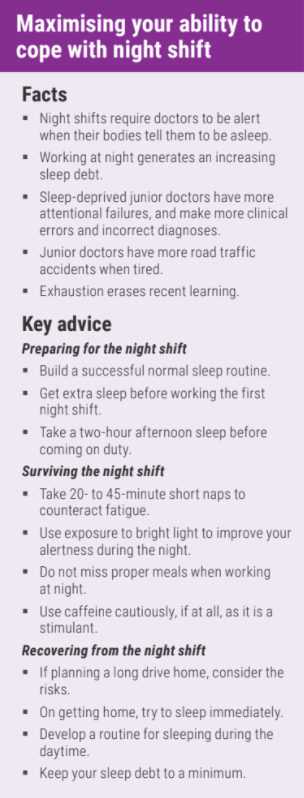

Blog

Good luck for a good night
Wednesday September 15, 2021
The push toward 24-hour medicine and the constant demands of the Four-Hour Rule have led to a significant increase in the number of doctors working shiftwork at nights in order to ensure speedy admissions and adequate ward cover.
While working at night has always been a part of a hospital doctor’s life, it was often as part of an on-call roster, as opposed to the formal night shifts making up a large portion of many current rosters.
It is a dangerous thing, however, to consider a night and day shift to be the same thing, as some medical workforce departments have recently suggested, even going so far as to move comfortable furniture out of common areas in order to prevent doctors from taking naps on night shifts.
A night shift can be a strange beast. While some of my best shifts have been nights, as I put more time into a wound closure, had a late-night Maccas run on Uber Eats with the nurses, or connected with a patient during a midnight log roll in a way the rush of the day shift does not allow, so have some of my worst.
There is less senior support around, and seeking it out means waking your boss, who will be variably impressed, and will also have to work the next day. Problems are less predictable and with your attention divided between a far greater patient load, deterioration feels more acute. The incessant beeping of machines, without the chatter of the day shift, added to the flashing of torches and flickering hallway lights can be haunting, and makes poor outcomes harder to process.
Occupational science has been looking at night-shift working patterns and found that not only are more errors made by night-shift workers, but they are involved in more accidents, both during and after their shifts. Sleeping during the day is difficult, especially for those with families at home, so there is a steady haze of fatigue and the temptation to self-medicate to help with sleep.
The AMA (WA) Industrial Agreement precludes more than four night shifts in a row – and for good reason. Sleep debt over successive night shifts is cumulative and has been shown as the equivalent of a blood alcohol concentration of 0.05-0.1 in some studies.
Tragically, the impact of excessive fatigue has even cost the lives of junior medical staff in WA in motor vehicle crashes after a night shift. Unlike our nursing colleagues with three formal shifts per day, there are often only two shifts a day to make up 24-hour medical cover, which means these night shifts, with appropriate handover at each end, are 13-14 hours long – and sometimes longer with paperwork.
So how do we reduce the risks to both patients and staff? A guide to improving safety on night shifts for junior medical staff by the Royal College of Physicians in the UK recommends, among other measures, regular short naps during night shift as an invaluable fatigue management measure:
Developing a napping routine is an indispensable part of working safely overnight. A ‘prophylactic’ afternoon sleep before you come on duty will help keep fatigue at bay, but taking a nap during the night is essential for maintaining vigilance and alertness. Naps are powerful means of staying refreshed, both before and while on duty, and even naps as short as 20 to 45 minutes have been shown to provide positive benefits to shift workers. 1
Responsible employers, looking out for the safety of their patients and staff should be looking for more ways to reduce fatigue over night shifts, including providing appropriate facilities for rest and replenishment, rather than rearranging the furniture in an attempt to drag a false productivity out of their overnight workforce.
Dr Megge Beacroft
Co-Chair, AMA (WA) Doctors in Training Committee
References:
1. Horrocks N. Pounder R. Working the night shift: preparation, survival and recovery – a guide for junior doctors. Royal College of Physicians, UK. rcpjournals.org/content/clinmedicine/6/1/61.full. pdf


